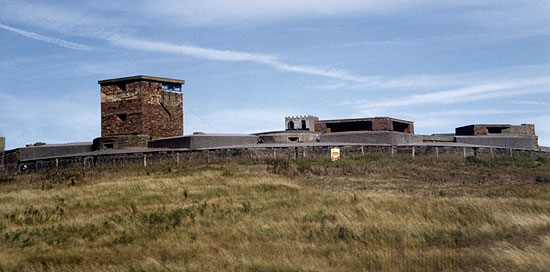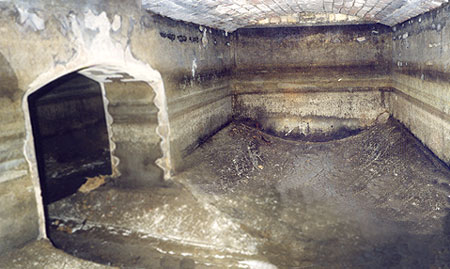Inspecting the drains
Posted: 15 August 2007 22:39
I found myself back over the border in Kent today, looking into drains. I spent the day at Dymchurch Redoubt on account of the research I've done on this fortification and its twin at Eastbourne.
Dymchurch Redoubt is one of the most fascinating buildings I've ever had the pleasure to set foot in. It was built 1805-08, rearmed and modified in c.1870, with extensive refortification occurring in c.1940-41 with the construction of bespoke pillboxes and the addition of an Emergency Coast Defence Battery. The photograph below shows the redoubt as it looked in 1998.

I was at the redoubt to help on the subject of drainage; as part of ongoing assessment of the structure, the exact design of the rainwater system needs to be established in order to reduce the moisture in the brickwork.

Rainwater was channelled off the roof and piped into four 3,000-gallon cisterns situated under the casemate floors.
The photo shows one of these cisterns at Eastbourne Redoubt; an identical second chamber lies beyond the archway.
The photo was taken in one of my many forrays into odd corners to change lightbulbs when I was a volunteer there some years ago. (A light was situated just below the entry manhole in order to illuminate the cistern to allow visitors to see down into it.)
The problem with this rainwater system is that the drainpipes from the roof were actually bricked up in the walls and their exact route and layout is not recorded in any of the plans of either Eastbourne or Dymchurch Redoubts, making it hard to work out what's going on and why the masonry is so damp.
This problem is not new though; in 1870 it was reported that
The magazines and casemates of...Dymchurch...Redoubt have been more or less damp, owing mainly to the rainwater pipes having been originally constructed within the walls and to filtration through the parapets, which are not asphalted. TNA WO 33/25
Documentary evidence for Dymchurch Redoubt is otherwise distinctly lacking, particularly for the World War Two period; the Fort Record Book for the Emergency battery is not in The National Archives, which for me is highly frustrating. This document should have included pages on the history of the battery, which is exactly what I want to know!
Anyway, my day was very interesting; Dymchurch Redoubt is one of my favourite fortifications and a very important one on account of its (known) history.
However, I'm by no means the first person to eulogise this defensive work; in 1818, one L. Fussell mentioned Dymchurch Redoubt in his book A Journey Round the Coast of Kent. I'll let him have the final word on the subject:
The spot was formerly occupied by a building called Brookman's Barn, by which appellation it is still better known by the inhabitants of the neighbourhood, than by its proper military name; and for want of knowing that circumstance, travellers have sometimes been not only inconveniently misled by the answers which they have received to their inquiries respecting the road, but have lost an opportunity of inspecting one of the most interesting of all the ingenious works constructed for the defence of the coast.
- Pete

Email:
Blog Latest

Bishopstone reveals its pillbox secrets
18 October 2021

Pillbox or Observation Post?
10 June 2020

Uncovering the hidden secrets of a pillbox
8 June 2019

Review of 2018
31 December 2018

Wartime Christmas in East Sussex (2)
24 December 2018
Jargon-buster
Emergency Coast Defence battery
As the name suggests, a battery established during wartime for coast defence to augment batteries established in peacetime. Emergency batteries established during 1940-41 usually employed a pair of old naval guns, usually either of 6-inch, 5.5-inch or 4-inch calibre.
Pillbox
Generic term for a hardened field defensive structure usually constructed from concrete and/or masonry. Pillboxes were built in numerous types and variants depending on location and role.
TNA
The National Archives (formerly The Public Records Office or PRO).
This site is copyright © Peter Hibbs 2006 - 2024. All rights reserved.
Hibbs, Peter Inspecting the drains (2024) Available at: http://pillbox.org.uk/blog/216530/ Accessed: 27 July 2024
The information on this website is intended solely to describe the ongoing research activity of The Defence of East Sussex Project; it is not comprehensive or properly presented. It is therefore NOT suitable as a basis for producing derivative works or surveys!